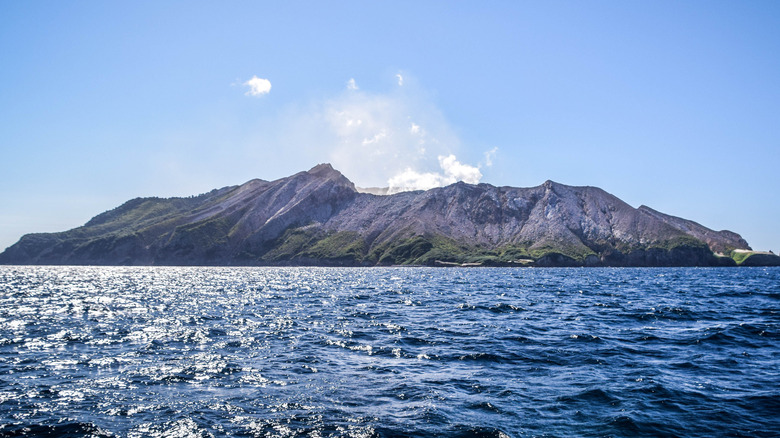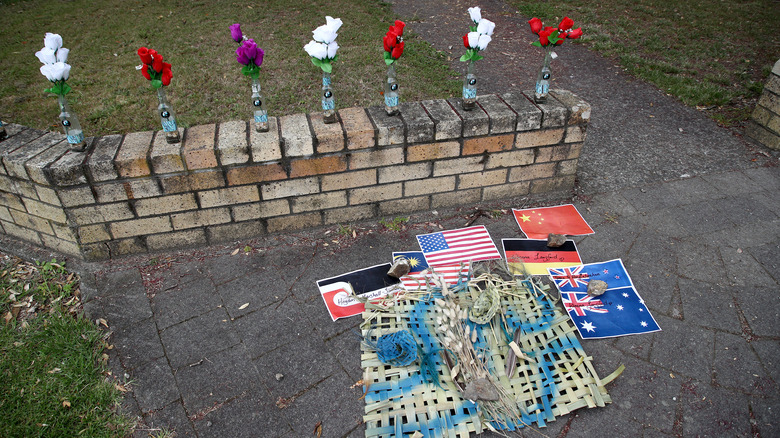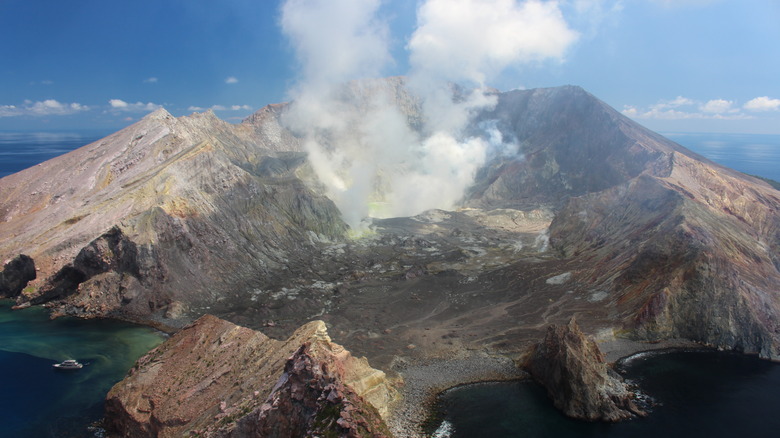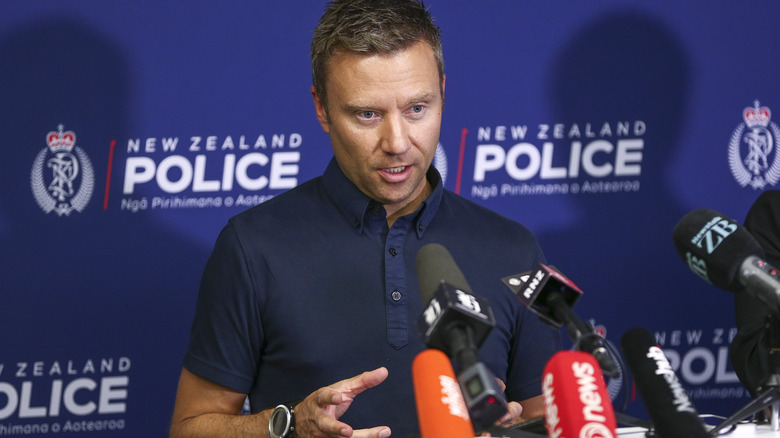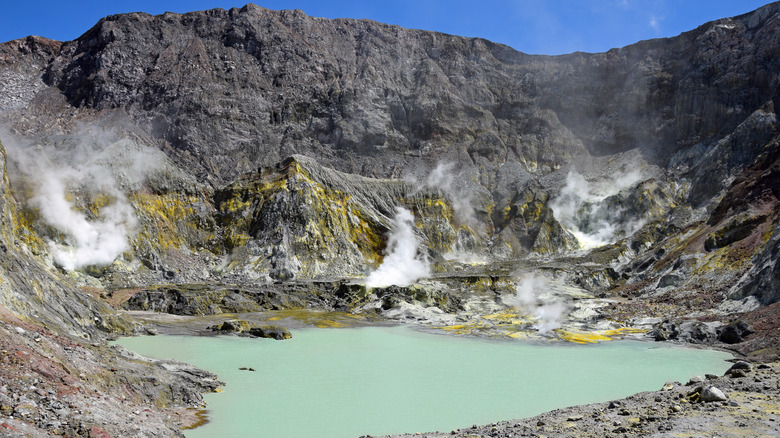The Horrific Story Of The 2019 Whakaari Island Volcano Eruption
Located 43 miles off the East Coast of New Zealand, Britannica writes that Whakaari Island was first discovered in 1769 by British explorer Captain James Cook. Per GeoNet, Cook named his discovery White Island. As Newsweek explains, the island is home to a cone-shaped underwater volcano. In 1997, the volcano and the island, estimated to be around 200,00 years old (via Whakatane), officially became known as Whakaari/White Island. Throughout its long history, Whakaari has garnered a reputation for being incredibly active and treacherous. Eruptions were recorded from 1975-2000, 2012-2013, and 2016. Despite this, Whakaari became a popular tourist destination.
Esquire reports that 10,000 people visit Whakaari annually. According to The New York Times, tours of the island costing hundreds of dollars were offered to anyone interested in walking the volcano's craters. Ray Cas, a volcanologist from Monash University, told the publication what tourists could expect on a visit to Whakaari. He stated, "You're walking into this enclosed amphitheater, onto the floor of a very active volcano where there are steaming gas vents, where there are crater lakes filled with hot water close to boiling temperatures."
On December 9, 2019, the volcano erupted while unsuspecting visitors explored Whakaari Island (per Esquire). In Cas' words (via The Independent), this was a "disaster waiting to happen for many years."
47 people were on the island when it erupted
At around 2:11 p.m. on December 9, 2019, Newsweek reported that Whakaari erupted. NPR writes that there were 47 tourists on the island. This included nine Americans and 24 Australians. Others were from New Zealand, China, Malaysia, and the United Kingdom. Esquire states that 38 of these tourists were from a cruise ship called Ovation of the Seas. Per The New York Times, Ovation of the Seas heavily advertised this excursion to Whakaari Island. In spite of recent volcanic activity, the cruise company and GeoNet, which is a geological monitoring system in New Zealand, assured that the Island was safe to visit.
Upon erupting, the island was engulfed in toxic gasses and ash (via NPR). Geoff Hopkins, a tourist who was on an offshore catamaran when the explosion occurred, told The New York Times what he witnessed. He stated, "It cut out the sun, it went dark. You couldn't see that there was an island there. It was completely covered in ash."
The Guardian notes that people fled the island, many with the help of fellow tourists. They also provided first aid as several individuals could not breathe properly or suffered burns. Esquire explains that, in the end, only 23 people were rescued from the island. Whakaari simply became too unsafe to continue search and rescue efforts.
Tourists were severely injured
When conditions at Whakaari were deemed stable, USA Today reported that New Zealand officials searched for tourists who were unaccounted for. However, Insider states that this was to recover bodies, not survivors. After weeks of searching with dive teams and helicopters, some bodies could not be recovered and efforts ceased (per CNN). Out of the 47 tourists that were visiting when Whakaari erupted, Esquire explains that 22 of them died while 25 others were injured. Per Newsweek, those who died did so because of their extensive injuries with some suffering burns on 80% of their body.
According to The Guardian, survivors also suffered substantial burns to their skin and lungs. This was due to the massive amounts of volcanic material spewed by Whakaari. The publication explains that survivors were distributed to four different hospitals in New Zealand for treatment. Dr. John Bonning from The Australasian College of Emergency Medicine noted that some survivors had ghastly injuries and faced years of recovery. He stated that some had "full thickness burns in significant parts of the body, in some cases 50% or more, requiring significant surgery and skin grafts and all sorts of other supports." Nevertheless, officials remained optimistic about their recuperation.
Survivor Stephanie Browitt speaks out
7NEWS Australia reports that one survivor of the Whakaari Island volcano eruption is Stephanie Browitt. Per the3 New York Post, she was visiting the island with her father and younger sister when tragedy struck. In an interview with 60 Minutes Australia, Browitt recounted the moment of the eruption. "You could hear the sound of all the rocks hitting the ground and people just screaming." She added. "I didn't think I would survive ... I thought I was going to die." Browitt lived, but her father Paul and sister Krystal did not. Ultimately, Browitt suffered burns to 70% of her body and lost several fingers.
7NEWS Australia writes that she underwent countless surgeries, laser treatments, and steroid injections to recover from her horrific burns. Browitt, who was in the hospital for six months, notes that she will forever miss how she used to look. In December 2021, two years after the eruption, People states that Browitt took to social media to speak about her survival and recovery.
She explained (via Instagram), "I'm extremely grateful that I was able to make it back home to my mum, but I'm also heartbroken that only I made it back. We are a family of four, not two. My heart hurts when I remember what I felt that day, but it hurts more not knowing what my dad and sister felt, that I wasn't next to them during their last moments." Now 26, Browitt uses social media to share what life is like as a burn survivor.
A New Zealand research agency faced criminal charges
The Guardian writes that the Whakaari Island volcano eruption was the deadliest volcanic disaster in New Zealand since the 1886 eruption of Mount Tarawera. That being said, The New York Times states that it's unclear how tourists were allowed to freely visit the privately-owned Whakaari without taking into account that the active volcano could erupt at any moment. Nearly a year after the tragedy, NPR reported that the New Zealand government charged 13 different entities for mishandling the wellness of its employees. A different article from The Guardian reports that WorkSafe, New Zealand's health and safety regulator, pushed for these charges.
Phil Parkes from WorkSafe noted (via The Guardian) that the eruption was "unexpected" but not "unforeseeable." Nature adds that GNS Science, a New Zealand-based research agency that studies the country's geological systems, was one of the parties charged. WorkSafe alleged that GNS Science should have evaluated "the structure, content and delivery of its volcanic alert bulletins" to have "effectively communicated the implications of volcanic activity." The agency later pleaded not guilty to these charges.
In October 2022, the charge regarding the volcanic bulletins was dropped (per Nature). However, GNS Science still faced charges for failing to ensure the safety of its employees. The Daily Mail explains that the ruling came after New Zealand's National Emergency Management Agency (NEMA) was cleared of any wrongdoing for its role in the disaster. According to Esquire, court dates for ten other parties are set for July 2023.
The Whakaari Island volcano could erupt again
Esquire writes that search and rescue efforts regarding the tragedy were also criticized. Help arrived over two hours after the explosion. Dr Tony Smith, who was involved in the process, told 60 Minutes Australia that more individuals would have survived if they had "flown to the island earlier." In the same interview, Stephanie Browitt agreed with this sentiment and expressed her anger that more was not done to ensure the survival of others. In fact, Browitt was rescued by tourist helicopter pilots, not an official search team. Smith insists that he was told that conditions rendered it impossible to land without putting his employees in harm's way.
Whakatane reports that Whakaari Island has been closed to tourists since the deadly eruption. At the time of this publication, Newsweek explains that Whakaari remains active but has not erupted. Shane Cronin, a volcanologist from the University of Auckland in New Zealand, told the publication, "The next eruption could happen at any time, given that the volcano can be triggered by several different mechanisms, both internal [new magma] or external [sealing of the top], both of which are highly unpredictable."
Although GNS Science monitors Whakaari's seismic activity, its equipment has not been maintained (per Newsweek). The agency plans to eventually return to the island for repairs. Nevertheless, Whakaari remains unpredictable and Newsweek notes that a future eruption could be more severe than the one that occurred in 2019.
